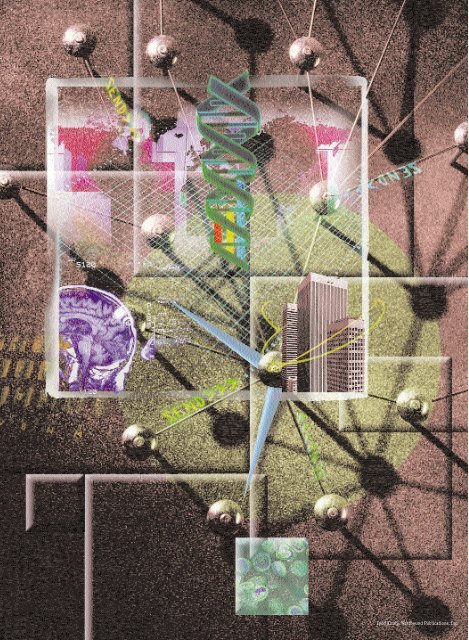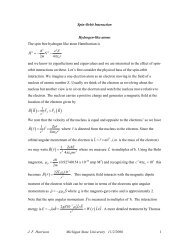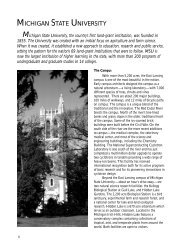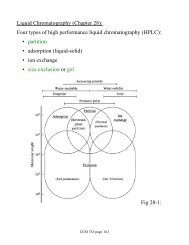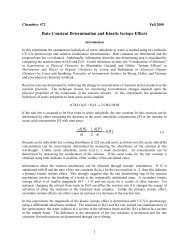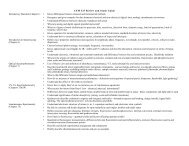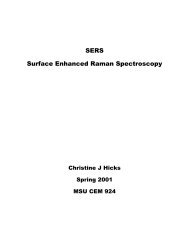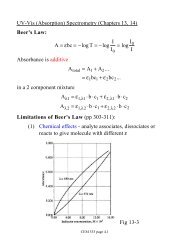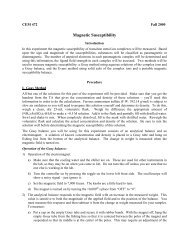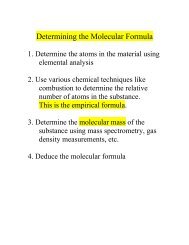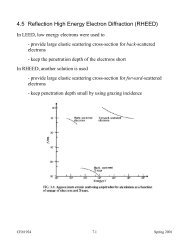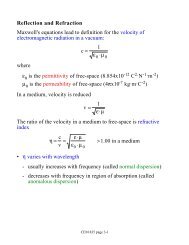chapter 5 - Department of Chemistry
chapter 5 - Department of Chemistry
chapter 5 - Department of Chemistry
You also want an ePaper? Increase the reach of your titles
YUMPU automatically turns print PDFs into web optimized ePapers that Google loves.
Todd Kiraly, Westbound Publications, Inc.
’90sFrom Mass Spec to Biotech:Survivingthe 20th CenturyMark S. LesneyThe Cold War is now behind us. Let usnot wrangle over who won it.— Mikhail Gorbachev, 1990In the 1990s, the promise and the perils <strong>of</strong> globalization—oneworld market, one world risk, and increasingglobal competition—continued to affect the world economyand the structure <strong>of</strong> the analytical instrument industry.Companies were absorbed in large conglomerates or boughtand sold, <strong>of</strong>ten as much for reasons <strong>of</strong> capital and stock issuesas for productivity or function. International marketing,multinational subsidiaries, and the rise <strong>of</strong> the World WideWeb transformed production, advertising, and sales <strong>of</strong> chemicalinstruments, tying the fortunes <strong>of</strong> industry to globalrather than local economic trends.©1999 American Chemical Society March 1999 Made To Measure 83
Previous general trends held as, approaching the new millennium,the “central science” led the transformation fromthe Age <strong>of</strong> the Atom to the Biotechnology Century. Whilemaintaining its role from previous decades, analytical instrumentationdramatically shifted emphasis from petrochemicalsto biologicals, from geophysics to genomics. Technologicaldemands from industries and research fields notpreviously associated with traditional chemical instrumentationled to additional innovations in simplification, standardization,computerization, and “small footprint” benchtopequipment that could be used by a changing and diversely educatedworkforce that serviced the economically affluentbaby-boom generation seemingly benton both “living forever” and having it all.Military technology continued to followits pattern <strong>of</strong> demanding high-techinstrumentation as superconductors,fiber-optics, computers, satellite sensing,and laser technology led the way.Regulatory analysis expanded in complexitybeyond individual pollutants toissues <strong>of</strong> global warming; biological andchemical warfare; and the subtleties <strong>of</strong>endocrine disruption, bioremediation,and the genetic damage <strong>of</strong> large-scalepopulations, including the former Sovietstates. The possibilities <strong>of</strong> nanotechnology,biological computers, robotics, andartificial intelligence became plausiblesources <strong>of</strong> innovation in instrumentationrather than fantasy.On the international front, the emergence<strong>of</strong> the European Union providedadded impetus for a business-friendlygovernment in the United States to lookfavorably on corporate mergers and international marketing,all <strong>of</strong> which affected the analytical instrumentationbusiness and the larger chemical industry dramatically.The vast majority <strong>of</strong> innovations in instrumentationwere not in new kinds <strong>of</strong> analysis (as in previous decades,when major new forms <strong>of</strong> chromatography or spectroscopycame to light) but rather in the area <strong>of</strong> enhancements andcombinations <strong>of</strong> instruments. The wealth <strong>of</strong> possibilities forinterfacing and combining analytical techniques seemedIt will be an era inwhich the boundariesbetween basic andapplied science erode.Commercial relevancewill be an intrinsicfeature if not a statedgoal <strong>of</strong> most science.— Frank Press, president <strong>of</strong>the National Academy <strong>of</strong>Sciences, 1992destined for the long-term goal <strong>of</strong> creating a multidimensionalanalytical technology using all the various methods<strong>of</strong> analysis. This was the promise <strong>of</strong> the creation <strong>of</strong> a virtualStar Trek “tricorder,” which would analyze all things for allpeople just by pointing at an object. Such a developmentwas the prediction <strong>of</strong> Tony White, Perkin-Elmer CEO, atPittcon ‘96.The Corporate LandscapeVery early on, the promise <strong>of</strong> the past decade was suddenlypulled up short, according to Lawrence Schmid, president <strong>of</strong>SDI, Inc. “A general instrument industry slowdown has beenunder way in the United States for thepast year,” he said. The reasons for thisvaried, but lowered government fundingand the sudden fear that biotechnologywould not live up to its promise were two<strong>of</strong> the most important reasons given [Today’sChemist 1990, 3(1)]. The low level<strong>of</strong> growth in gross national product (GNP)was the final straw. Referring to Pittcons‘90 and ‘91, Schmid projected that “theinstrument industry appears to be takinga conservative view <strong>of</strong> the future whichdoes not include accelerated product developmentprograms.” Referring toPittcon ‘93, Ward Worthy wrote, “Therewas a sort <strong>of</strong> consensus . . . that the glorydays <strong>of</strong> the 1980s, when annual double-digitgrowth rates were the norm,were gone.” The analytical instrumentindustry was relatively flat [TCAW 1993,2(4)].“The trends in the late 1980s continuedthrough 1990; mergers and acquisitionsincreased in size and frequency.” [Today’s Chemist1991, 4(2)]. Later in the decade, Spectronics left Milton Roywhen purchased by Life Sciences International (LSI) in1995; Teckmar and Dohrman merged in 1995. AnalyticalTechnology Inc. (ATI) took over Orion, Mattson, Unicam,Russell, and Cahn. Both ATI and LSI were eventually sold toThermo Instruments Systems.The Thermo line <strong>of</strong> companies, all subsidiaries <strong>of</strong> ThermoElectron (founded in 1956), were by far the most amazing ex-84 Made to Measure March 1999 http://pubs.acs.org
Click here to see full sizeAnalytical Products Group, Inc.advertisementand to link toElectronic Reader Service
Click here to see full sizeVarianadvertisementand to link toElectronic Reader Service
Click here to see full sizeVarianadvertisementand to link toElectronic Reader Service
Click here to see full sizeCorningadvertisementand to link toElectronic Reader Service
ample <strong>of</strong> these corporate acquisitions. Thermo entered theinstrument business in 1970 with the development <strong>of</strong> a gasphasechemiluminescence analyzer for the automobile industryand made its first acquisition in 1979: Eberline Instruments.However, it was the decade <strong>of</strong> the 1990s that saw the largestgrowth. Thermo acquired Finnigan in 1990; Nicolet in 1992;Gamma-Metrics, Hilger Analytical, and Spectra-Physics Analyticalin 1993; IRT and CID Technologies in 1994; and Baird in1995. Also in 1995, Thermo bought Fison’s instrument division.Thermo had its own spin<strong>of</strong>f companies (e.g., Thermo Opteck,ThermoQuest, ThermoBioAnalysis, and ThermoSpectra)throughout the 1990s.In this period, joint ventures also become popular toincrease competitive edges: Dow Chemical joined with BPChemicals to compete against Exxon Chemical’s alliancewith Union Carbide in the development <strong>of</strong> technologies forlow-density polyethylene production. An even greaternumber <strong>of</strong> corporate collaborations formed to exploit thenew biotechnology (see “Biology Rules” section below).Stocks entered an amazing bull market in the latter half <strong>of</strong>the 1990s: The Dow–Jones Industrial Average was 4000 in1995, 7000 in 1997, and 9000 in 1998.Downsizing became a fact <strong>of</strong> life for companies eager to increaseproductivity. Because <strong>of</strong> downsizing, career issues <strong>of</strong>survival and advancement became critical concerns for industrialchemists. In 1995, despite higher production and pr<strong>of</strong>its,the chemical industry had fewer workers than any time in nearlyeight years, even though employment still held up betterthan in many other manufacturing sectors [TCAW, 1995, 4(9)].A backlash against business appeared in the popular media.Cartoons such as “Dilbert” (regularly used in Omega Engineeringads after mid-decade) achieved a huge following as theymade fun <strong>of</strong> concepts <strong>of</strong> productivity, management schemes,downsizing, and corporate loyalty.Trends in InstrumentationDownsizing led to other changes, said a spokesperson for OrionResearch in an interview for this article: “The corporate Americantrend <strong>of</strong> downsizing meant that unskilled workers <strong>of</strong>tenwere being asked to run difficult chemical analyses. Our products<strong>of</strong>ten can be used to replace complex methods with muchsimpler ones, and we have seen this trend grow.”The push toward automation and ease <strong>of</strong> use in more complexinstruments was evident. Equipment evolved beyond thehttp://pubs.acs.orgneeds <strong>of</strong> advanced chemical knowledge: black-boxed for newusers and new uses. Computerized displays and automationenhanced this disconnect between the science and the userfor industry and the service laboratory—as had happened earlierfor clinical labs. Part <strong>of</strong> this trend was the push towardeasy data visualization and data management, which was promulgatedby companies such as Justice S<strong>of</strong>tware. Automationand the use <strong>of</strong> robotics were increasingly common, especiallyin pharmaceutical applications such as high-throughputscreening. One example <strong>of</strong> this was the Biomek IntegratedLaboratory enzyme-linked immunosorbent assay (ELISA) system.Also, a series <strong>of</strong> benchtop mass spectrometers was availablefrom Finnigan, Hewlett-Packard (HP), and othercompanies. And answering the dual demand for easy automationand life sciences instrumentation, Gilson produced the234 Autoinjector for HPLC in 1995.There certainly was a host <strong>of</strong> new wrinkles on old technologies.There was membrane-interface mass spectrometry(MIMS) and matrix-assisted laser desorption analysistime-<strong>of</strong>-flight mass spectrometry (MALDI-TOF MS); therewas capillary electrochromatography (a hybrid <strong>of</strong> LC andcapillary electrophoresis [CE]—electrophoresis with apacked column). The use <strong>of</strong> fiber-optics increased in variousforms <strong>of</strong> surface analysis, especially IR and near-IRspectroscopy. Single-molecule and -atom analysis andvisualization became possible using new forms <strong>of</strong> microscopy,paving the way for advances in nanotechnology.In 1994, CIBA-GEIGY and the Oak Ridge National Laboratory(ORNL) introduced the analytical “lab-on-a-chip”: a microchipthat performed reactions and analyzed the resultsby using CE. This development followed the production <strong>of</strong>the 1993 DuPont “chemical plant on a chip” and the 1991Affymax DNA-array microchips.Computer and s<strong>of</strong>tware advances continued unabated. Theyear 1994 was remarkable in that more computers than televisionsets were sold. Continuing the push toward ease andminiaturization, Cray produced its deskside supercomputer,the EL94. By 1992, desktop molecular modeling was becomingroutinely available in products such as Alchemy III fromTripos and Autodesk’s HyperChem, as PCs and Macintoshesspread to more and more laboratories. Artificial intelligence(AI) and expert systems became ever more applicable andpowerful, and not only for chromatography: Witness GarryKasparov’s 1997 defeat at chess by an IBM computer.March 1999 Made to Measure 89
The Mosaic browser, developed in 1993 by a student, MarcAndreessen, and Eric Bina <strong>of</strong> the National Center for SupercomputingApplications, “did more than any other developmentto bring about the phenomenal growth <strong>of</strong> the Web andthe Internet” [TCAW, 1995, 4(4)]. There were only 100 Websites in 1992, but hundreds <strong>of</strong> thousands by the end <strong>of</strong> thedecade. With the development <strong>of</strong> the Internet came “[a] newtrend: using the Internet to provide information and supportfor products and services” [TCAW, 1995, 4(4)]. Some examples<strong>of</strong> the enhanced use <strong>of</strong> the Web were the arrival <strong>of</strong> AmericanChemical Society (ACS) journals online and the ASAP (AsSoon As Publishable) publishing system for rapid release <strong>of</strong>articles, the availability <strong>of</strong> Pittcon ‘97 Web sites, and, in 1998,the ACS presentation <strong>of</strong> “Pittcon Live” on the Internet.Environmental FluxAt first, even the environmental movement seemed to haveslowed, despite the celebrations <strong>of</strong> the 20th anniversary,Earth Day and the comments <strong>of</strong> Jim Byrne, president <strong>of</strong>Centcom, who announced at the 1990 Pittcon that “environmentalanalysis [was] undoubtedly one <strong>of</strong> the most significantgrowth areas for analytical instruments” [Today’sChemist, 1990, 3(4)]. Part <strong>of</strong> the problem was a backlashagainst what was seen as environmental excess. Articles inToday’s Chemist at Work emphasized what the writers saw asoverreaction to the dangers <strong>of</strong> chlorinated compounds,global warming, pesticides, dioxins, lead, and other environmental“risks.” In 1990, Patrick P. McCurdy, then editor<strong>of</strong> Today’s Chemist at Work, said, “Some scientists even seegood in global warming.” Contributing editor Ken Reese remarked,“Bashing lead, in fact, quite apart from the merits<strong>of</strong> specific cases, has become politically correct” [TCAW1995, 4(3)].Antiregulatory-versus-environmentalist battles grew evermore heated. “Everything in life is full <strong>of</strong> one-in-a-hundredrisks. If the EPA [U.S. Environmental Protection Agency] isspending all its time trying to protect the public againstone-in-a-million hypothetical risks, then it’s spending itstime on trivia,” A. B. Nichols said [TCAW, 1992, 1(4)]. Congressionalbacklash in 1995 led to Republican moves toslice the EPA budget 34% and attempts to provide industryimmunity to certain Superfund liability provisions.One key triumph was overturning what had been seen asonerous overregulation. The hated Delaney clause was replacedin 1996 with far less restrictive requirements than“zero tolerance.”The 1995 Nobel Prize in <strong>Chemistry</strong>, awarded to PaulCrutzen, Mario Molina, and F. Sherwood Rowland, whobroke the news on ozone depletion, was seen by most as avindication <strong>of</strong> their work. Still, antienvironmentalists complained“that the ozone depletion theory is based on badscience” and that the award was “a desecration upon theheritage <strong>of</strong> Alfred Nobel” [TCAW 1996, 5(10)].On the whole, the public did not appreciate attempts tocounter regulations, nor did they share in the view <strong>of</strong> a putuponindustry. Opinion polls conducted by the Chemical ManufacturersAssociation (CMA) in 1990 found that “there [was] alack <strong>of</strong> trust in chemical manufacturers on the part <strong>of</strong> the public;indeed, people [did] not like the chemical industry as awhole” [Today’s Chemist, 1990, 3(2)]. And even though the author<strong>of</strong> a February 1992 Money magazine poll claimed thatchemists had “excellent” prestige, according to Today’s Chemistat Work, this label did not apply to the industry in which theyworked [TCAW, 1992, 1(4)]. As seen by the early CMA poll, theissues <strong>of</strong> antiscience and antichemical industry grew in importance.Polls taken in the latter part <strong>of</strong> the decade still showedthat a favorable opinion toward the chemical industry wasbarely higher than 20%, despite the efforts <strong>of</strong> the ResponsibleCare program, inaugurated in the 1980s.In 1992, promoting the spirit <strong>of</strong> voluntary self-regulation,the CMA adopted the Product Stewardship Code as part <strong>of</strong> ResponsibleCare and imposed a deadline for member adoption.The Green <strong>Chemistry</strong> program was another attempt at environmentallybenign and consumer-friendly manufacturing.In 1995, the Presidential Green <strong>Chemistry</strong> Challenge Awardswere established to reward companies that had managed tomake the transition to “green” manufacturing practices. InEurope, throughout the 1990s, HP spent nearly $1 million ayear on the popular Rhine Basin Program, which by 1997 hadexpanded to include environmental monitoring <strong>of</strong> 15 otherrivers and was expanding its partnership with various Europeanauthorities.As a result <strong>of</strong> this new wave <strong>of</strong> environmental and healthgive-and-take between industry and the general public, riskand risk assessment became hot topics. To deal with this issue,in 1995 Chemical & Engineering News sponsored a symposiumentitled “Risk Issues and the Chemical Industry: TheSummit on Risk-Based Public Policy.”90 Made to Measure March 1999 http://pubs.acs.org
Click here to see full sizeNicoletadvertisementand to link toElectronic Reader Service
There were a number <strong>of</strong> reasons for the environment to beon everyone’s mind in the 1990s. In 1991, deforestationaround the world was projected at 40 million to 50 millionacres per year; Mount Pinatubo erupted in the Phillippines—the largest such eruption in the 20th century—causing transientglobal cooling and further erosion <strong>of</strong> the ozone layer;during the Persian Gulf War, Iraq ignited Kuwaiti oil wells,creating tremendous air and water pollution; and a massivecyclone killed more than 100,000 people in Bangladesh.In 1992, the crater <strong>of</strong> the asteroid strike purported tohave caused the extinction <strong>of</strong> the dinosaurs nearly 65 millionyears ago was discovered on the Yucatan Peninsula,and the Rio Earth Summit led to a world treaty on biodiversity.Chlor<strong>of</strong>luorocarbon (CFC) production was <strong>of</strong>ficiallybanned by the end <strong>of</strong> 1995; companies such as Forma Scientificadvertised the first non-CFC refrigerants just in time.And in late 1997, 160 nations reached consensus on a globalwarming accord in Kyoto, Japan, much to the distress <strong>of</strong>many American industrialists, scientists, and politicians(for example, Willis Witters <strong>of</strong> the Washington Times). Also,according to meteorologists cited in The Washington Post,1998 was the hottest year on record (J. Warrick, The WashingtonPost, Dec. 18, 1998, p. A12).As a bottom line, the environmental technology market wasexpected to reach $500 billion worldwide by the year 2000.New Laws and RegulationsNot coincidentally, despite some successes at deregulation,even more regulations were applied to the chemical industry.EPA continued to be at the forefront <strong>of</strong> this issue. In 1991,the Clean Air Act identified 189 compounds in air as toxic,and EPA estimated that 20% <strong>of</strong> the five million undergroundpetroleum storage tanks in the United States were leaking.The U.S. Food and Drug Administration (FDA) also continuedto influence and regulate. In 1990, the Nutritional Labelingand Education Act made FDA-regulated food labelinga requirement on supermarket shelves. In 1992, the FDA declareda moratorium on silicone breast implants; this moratoriumled to successful legal suits and the bankruptcy <strong>of</strong>Dow-Corning. In 1996, the Food Quality Protection Act establishednew safety standards for pesticides in all foods,both raw and processed (in part to replace the DelaneyClause), and the FDA established fast-track approval for cancerdrugs similar to its program for acquired immune deficiencysyndrome (AIDS) drugs.Globalization especially led to new and complex regulatoryrequirements for operating in a world market. Highlightingcompliance with the International Standards Organization(ISO) became the thing to do in the 1990s, because proclaimingcompliance with local rules was a thing <strong>of</strong> the past. Onead from Analytical Products Group stated, “We’re in compliance.Aren’t we?” Many companies advertised their compliancewith ISO 9000, 9001, and 9002; many simply put anISO-certified or ISO-registered logo in their ads. ISO 14000,designed for environmental management and life-cycle assessment,debuted in 1996.EPA, <strong>of</strong> course, still retained its clout in the United States:Restek Corp., for example, advertised that its Rtx-CLPesticidescolumn rapidly analyzed “all 22 pesticides in EPAMethod 8081 in less than 25 minutes.” In 1996, a record number<strong>of</strong> EPA enforcement actions were taken. In 1997, EPAchanged its proposed air monitoring regulations to includeCompliance Assistance Monitoring and “Any Credible Evidence,”which threatened industry with new lawsuits asmuch as it freed them <strong>of</strong> regulatory strictures.Standardization, <strong>of</strong> course, was critical with new regulations.In 1995, the American Association for Laboratory Accreditation(A2LA) set chemical standards for analysis thatwould prove acceptable to both EPA and ISO 9001 as a certifyingthird-party agency; by 1994, it became the only agencydeemed acceptable for such certification. In 1995, the NationalEnvironmental Laboratory Accreditation Conference(NELAC) convened to bring together industry, government,and academic laboratories interested in receiving accreditation.The director <strong>of</strong> NELAC also became the director <strong>of</strong> theNational Environmental Laboratory Accreditation Program(NELAP) with a mandate to accredit laboratories according tostandards set by the EPA.As a side note, in 1997 the National Association <strong>of</strong> Manufacturersclaimed that the Occupational Safety and HealthAdministration (OSHA) was neither kinder nor gentler, becausepaperwork violations ranked number one.Research and DevelopmentR&D funding by American corporations fell precipitously inthe 1990s as management became more short-term orientedand risk averse. This corporate economic conservatismwas detailed in the Feb. 6, 1995, issue <strong>of</strong> Chemical & EngineeringNews and was a logical outcome <strong>of</strong> the economicdownturn. Life sciences helped <strong>of</strong>fset the R&D declinesomewhat. In 1993, pharmaceutical companies outspentchemical companies in R&D even as general basic research’spercentage <strong>of</strong> the funding pie continued a 20-year decline.In 1994, the National Science Foundation (NSF) establishedsix new engineering research centers (ERCs) to focus ontechnologies to enable innovation in industry. In 1995, the<strong>Department</strong> <strong>of</strong> Defense (DOD) established a DOD industrycost-sharing program called the Technology ReinvestmentProgram (TRP), one <strong>of</strong> several ways to keep up defensespending while attempting to find a mutually accommodatingpeace dividend. But still, with generalized governmentcutbacks, total R&D in the United States was deemed virtuallystagnant. More, deeper cutbacks in government fundingwere projected [C&EN, 1995, 73(35)].Universities had their own problems. In 1992, NicholasDarby, a Dow Chemical Company research manager, summarizedthe situation: “ Leadership in many branches <strong>of</strong> chemistryresides outside the traditional academic boundaries.In many areas, industrial laboratories have assumed theleadership. Other academic departments, such as biochemistry,genetics, microbiology, chemical engineering, andeven mathematics, have stolen a march in other fields <strong>of</strong>chemistry” [TCAW 1992, 1(5)].Much <strong>of</strong> the latter was, no doubt, due to the increasingimportance <strong>of</strong> biotechnology and the biomedical field. Inanother attempt to attract private dollars in the 1990s,biotechnology institutes to foster university–industry researchbecame even more common.Biology RulesLife sciences and biotech became increasingly more importantas the decade progressed. A Shimadzu ad in 1996 symbolizedwell the zeitgeist <strong>of</strong> the chemical instrumentationworld in the 1990s by combining DNA, a world map, a femalescientist, a graphic analytical trace, pharmaceuticals, laboratorychemicals, a woodland stream, and the ISO 9000 into onepicture. The only thing missing was the computer—whichwas obliquely supplied in the Brinkmann 1996 laboratory92 Made to Measure March 1999 http://pubs.acs.org
Click here to see full sizeNicoletadvertisementand to link toElectronic Reader Service
Click here to see full sizeO • I • Analyticaladvertisementand to link toElectronic Reader Service
products guide, whose cover was illustrated with only a DNAmolecule, a flask, and a stylized data pad. In 1996, Beckmantouted “bio-spectrophotometry” with a line <strong>of</strong> biospectrophotometers.Reflecting the trend, the Analytical InstrumentsAssociation (AIA) changed its name to the Analytical and LifeScience Systems Association (ALSSA).In the early 1990s, Raman spectroscopy, taking advantage<strong>of</strong> the enhancements possible from combination with sophisticateddye lasers, was used in numerous biological applications,including fiber-optics technology (to study disease processesin the body), enzymology, and whole-cell studies.The AIDS epidemic continued. By 1991, 10 million humanimmunodeficiency virus (HIV)–infected adults hadbeen reported in 162 countries worldwide. Estimated projectionsfor worldwide infections by 2000 are more than 40 million.Although a boon to biomedical research, the AIDSepidemic was both a current and a present bane to the healthcare-providing system. Health care costs rose at three timesthe rate <strong>of</strong> inflation, and demands for health care reform werein part protests against increased costs <strong>of</strong> medicines and medicaltechnologies, especially for antiviral drugs such as AZT.Emerging technologies, mostly biological, “including combinatorialchemistry, genomics, and microchemistry” were keytopics for discussion at ALSSA’s 1997 Senior Management Conference.In the late 1990s, AIA/ALSSA members accounted foralmost 90% <strong>of</strong> the North American instrument market. Combinatorialchemistry and drug discovery were indeed extremelyimportant in the 1990s. Companies such as Optiverse <strong>of</strong>feredhighly diverse stock libraries for drug discovery by using methodsdesigned by Tripos and Panlabs. This <strong>of</strong>fering was similar tothe way biotech companies had earlier <strong>of</strong>fered cloned genesor vectors. Particularly important were computerized methodsfor managing and analyzing the discovery process. Automatingthe process was critical. By using the Tecan Genesisliquid-handling platform, for example, Tecan produced itsCombiTec for solid-phase synthesis for drug discovery, andGilson produced an automated combinatorial chromatographysystem. So important was the field that in 1996, a Combinatorial<strong>Chemistry</strong> Consortium was formed by a number <strong>of</strong> drugcompanies in conjunction with Molecular Simulations Inc.(MSI) to develop s<strong>of</strong>tware for enhancing the discovery process.Bioinformatics began its rise to prominence. Gene-sequencings<strong>of</strong>tware was dominated by Perkin-Elmer at 67% followedhttp://pubs.acs.orgby Oxford Molecular Group at 7%, although Oxford dominatedthe sequence analysis market. According to an interview inChemical & Engineering News, in the first quarter <strong>of</strong> 1998, 10%<strong>of</strong> biotech venture capital went into bioinformatics. By 1997,computational chemistry had become a “must-have tool”[C&EN, 1998, 76(42)].In 1997, more than 40 s<strong>of</strong>tware-only companies for thechemical industry existed, and the s<strong>of</strong>tware market was nearlydoubled from the year before. Much <strong>of</strong> this growth was basedon the huge push to sequence the human genome. By the early1990s, the first comprehensive maps <strong>of</strong> human chromosomeswere becoming available as part <strong>of</strong> the federally funded HumanGenome Project (HGP). By 1997, all 4.6 million base pairs in theE. coli genome had been sequenced. In 1998, the completegenome <strong>of</strong> C. elegans, a soil nematode, was mapped. Thisachievement was a milestone in genetics and molecular biology;it was the first multicellular animal whose DNA was completelysequenced, in part through funding for the HGP. Also in1998, Germany’s Bayer and America’s Millennium Pharmaceuticalsannounced a $465 million drug discovery collaborationbased on Millennium’s genome research. So promising was thehoped-for fallout <strong>of</strong> genomic science on medical technologythat in 1998, both Incyte Pharmaceuticals and Celera Genomics(a Perkin-Elmer business unit) announced their determinationto sequence the human genome privately. Glaxo Wellcome,Merck, Pfizer, and SmithKline Beecham all developed “internalprograms to manage the huge volumes <strong>of</strong> proprietary and publicdata” developing from gene-sequencing efforts.Other technologies proved useful to the new biology. By1998, MALDI, developed in the late 1980s by Karas and Hillenkcampin Germany, and by Tanaka and co-workers at theShimadzu Corp. in Japan, when combined with TOF/MS, hadentered the realm <strong>of</strong> bacterial identification, DNA and proteinsequencing, and the life sciences in general. DNA andprotein sequencers, enhanced HPLC, and almost any <strong>of</strong> thetraditional instruments could be and were fine-tuned towardlife science applications.The genetic engineering <strong>of</strong> transgenic plants and animals aswell as drugs had come into its own by the middle <strong>of</strong> the 1990s.In 1994, the first transgenic bull sired cows that produced humanlact<strong>of</strong>errin in their milk. By 1995, mice with transgenichuman antibodies were available. In 1996, Dolly the sheep, thefirst cloned animal, was born.March 1999 Made to Measure 95
By the end <strong>of</strong> the decade, Monsanto and Novartis were marketingliterally tons <strong>of</strong> seed for genetically engineered corn andsoybeans. Meanwhile, the companies faced an increasing backlashfrom environmental groups such as Greenpeace, especiallyin the European Union.Chemical companies continued major pushes into the lifesciences, in part by divesting non–life sciences divisions andacquiring additional life sciences companies. Monsanto,DuPont, Hoechst, and Dow, among others, followed thistrend. In 1998, the leading biotech drugs surpassed $1 billionin annual sales for the first time.Click here to see full sizePETROLABadvertisementand to link toElectronic Reader ServiceNo More Revolutions?In 1995, it was announced in Today’s Chemist at Work thatPittcon ‘95 was evolutionary, rather than revolutionary, because<strong>of</strong> the dearth <strong>of</strong> new technologies compared with previousdecades. Similarly, at the Centcom Breakfast at Pittcon ‘97, LouisT. Rosso, chairman and CEO <strong>of</strong> Beckman Instruments, summarizedthe state <strong>of</strong> the modern analytical instrument business.“We are reaching the top <strong>of</strong> the classical ‘S’ curve, and therehave been few big breakthroughs technically in this industryover the last 10 years . . . And, as you look around the industry,you see consolidations, mergers, you see acquistions, yousee certain companies exiting the industry, and you see manycompanies philosophically looking more and more at internalefficiencies . . . Some <strong>of</strong> the things we all thought were so afew years ago just aren’t anymore . . . that great technologywas all we needed for success, that science as a business wouldnever stop growing, that government would always supportincreased university research, that regulators would enforcelaws . . . that access to university-generated science is free,that we can raise prices every year, and get higher prices overseas. . . These things just aren’t so anymore.”Now, the millennium.Stock photography supplied by: Archive Photos, American Stock,Camerique, Express Newspapers, Lambert and ThorntonnClick here to see full sizePCR-Chiral, Inc.advertisementand to link toElectronic Reader ServiceSources for the History ChaptersAnal. Chem.; issues from the years 1948–1999.Chem. Eng. News 1998, 76(2), 75th Anniversary issue.Chemicals and Long-Term Economic Growth: Insights from the Chemical Industry;Arora, A.; Landau, R.; Rosenberg, N., Eds.; Wiley: New York, 1998.Chronicle <strong>of</strong> America; Daniel, C.; Kirshon, J. W.; Berens, R., Eds.; JL InternationalPublishing: Liberty, MO, 1993.Grun, B. The Timetables <strong>of</strong> History; Simon & Schuster: New York, 1991.Hellemans, A.; Bunch, B. H. The Timetables <strong>of</strong> Science; Simon & Schuster:New York, 1988.A History <strong>of</strong> Analytical <strong>Chemistry</strong>; Laitinen, H. A.; Ewing, G. W., Eds.; AmericanChemical Society: York, PA, 1977.Housnell, D. A.; Smith, J. K., Jr. Science and Corporate Strategy: Du PontR&D, 1902–1980; Cambridge University Press: Cambridge, 1988.Hudson, J. The History <strong>of</strong> <strong>Chemistry</strong>; Chapman & Hall: New York, 1992.Hyde, A. J. The Development <strong>of</strong> Modern <strong>Chemistry</strong>; Dover: New York, 1984.Johnson, L.; Schaffer, D. Oak Ridge National Laboratory: The First FiftyYears; The University <strong>of</strong> Tennessee Press: Knoxville, 1994.Kevles, D. J. The Physicists; Vintage Books: New York, 1979.McDonell, H. G. Evolution <strong>of</strong> Analytical Instrumentation: The Perkin-ElmerStory; Pittsburgh Conference Paper No. 379; Perkin-Elmer Corporation:Norwalk, CT, 1980.75 Years <strong>of</strong> Chromatography—A Historical Dialogue; Ettre, L. S.; Zlatkis, A.,Eds.; Elsevier: New York, 1979.Stephens, H. Golden Past Golden Future: The First Fifty Years <strong>of</strong> Beckman Instruments,Inc.; Claremont University Center: Claremont, 1985.Tindall, G. B.; Shi, D. E. America: A Narrative History, 4th ed.; Norton: NewYork, 1996; Vol. 2.Today’s Chemist; issues from the years 1988–1992.Today’s Chemist at Work; issues from the years 1992–1999.Wilson, M. K. The Top Twenty and the Rest: Big <strong>Chemistry</strong> and Little Funding;Annual Review <strong>of</strong> Physical <strong>Chemistry</strong>, Vol. 26, pp. 1–16, 1975.96 Made to Measure March 1999 http://pubs.acs.org
Click here to see full sizeGilson, Inc.advertisementand to link toElectronic Reader Service


